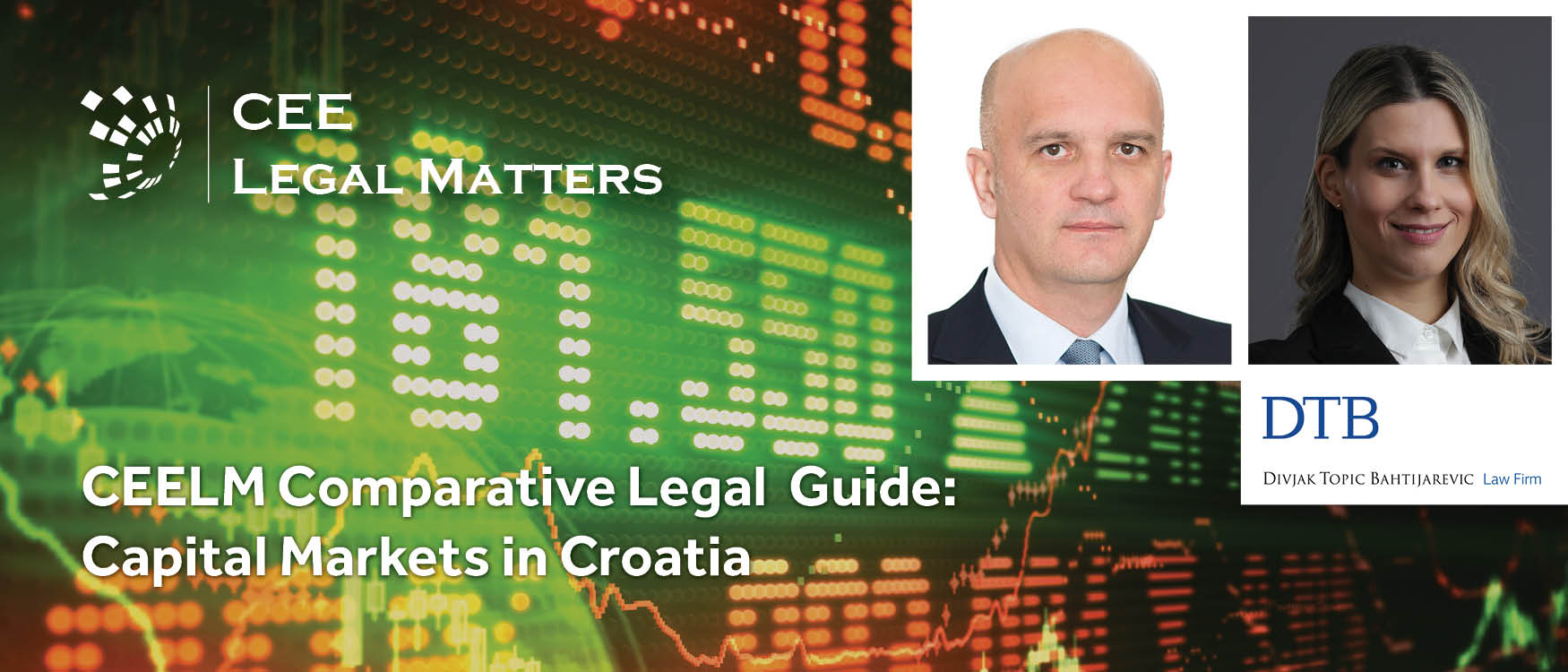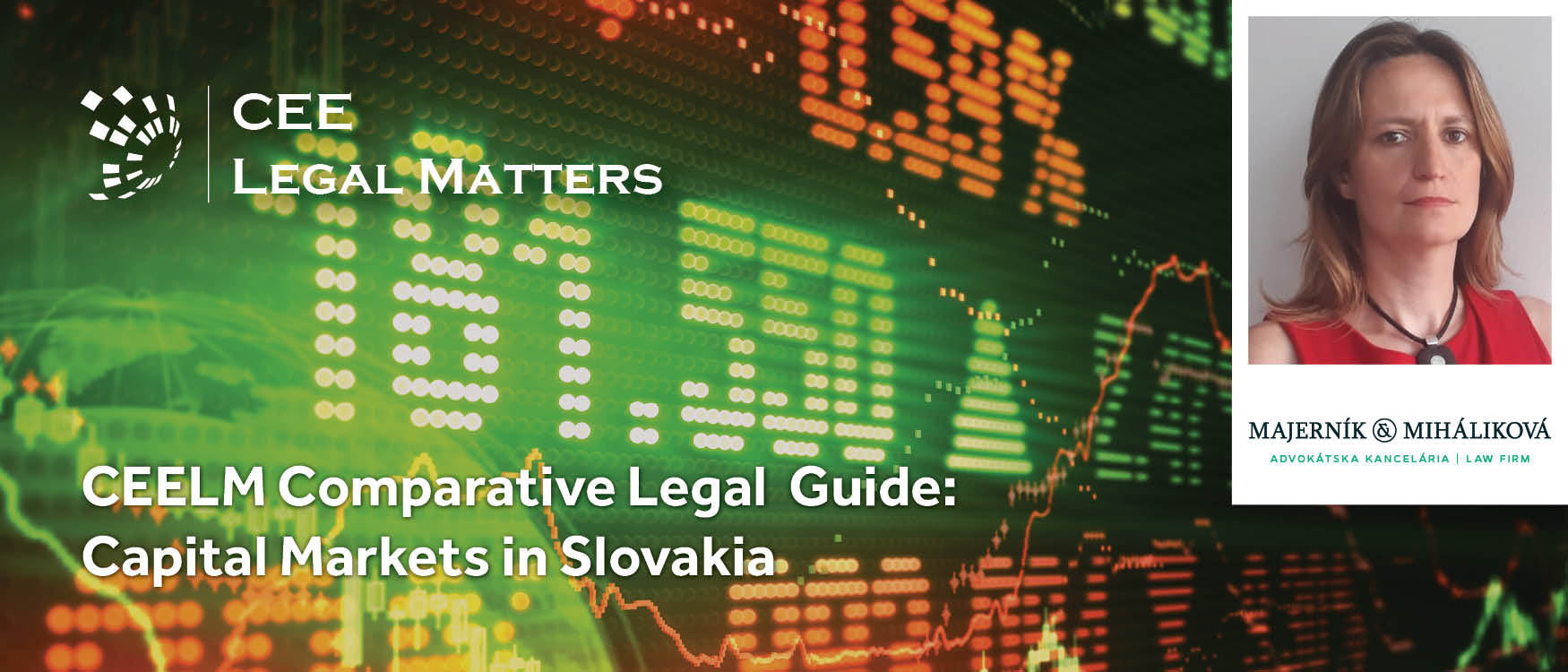Contributed by Karanovic & Partners.
1. Market Overview (biggest ECM and DCM transactions over the past 2-3 years)
The capital market in Serbia is still under development. Serbia’s capital market took a pause from the Second World War until the last decade of the twentieth century during which period Serbia did not have a market-based economy, and its economy was governed by socialist principles. At the end of the twentieth century Serbia reaffirmed a market economy and started redeveloping its capital market. While number of measures have been taken in that direction (for example, almost all joint stock companies had to be listed, as a result of which even today there is a proportionally significant number of listed companies in Serbia), there is still a long way to go.
The Belgrade Stock Exchange (BELEX) is the only stock exchange in Serbia. It recorded a total turnover of approximately EUR 534 million in 2018 (information for 2019 is not yet available). Securities traded on BELEX include shares, bonds of the Republic of Serbia, and bonds of the European Bank for Reconstruction and Development. Therefore, the debt market in particular has a room for improvement.
In 2018, the first initial public offering (IPO) of shares in almost 80 years was successfully completed in Serbia. Shares of Fintel Energy a.d. Belgrade were included on the Prime Listing and after the successfully-completed IPO the company’s stock trading started on 20 November 2018.
2. Overview of the local Stock Exchange and listing segments (Regulated and Non-regulated markets)
The capital market in Serbia is primarily regulated by the Law on Capital Market and related by-laws (the “Law”) and the main regulator is Securities Exchange Commission of Serbia (SEC).
In accordance with the Law, the Serbian capital market is structured in the following manner:
- regulated market, comprising of:
- listed segment, and
- non-listed segment,
- multilateral trading facility (MTF), and
- over-the counter (OTC) market.
In terms of the Law, a public company is an issuer which meets at least one of the following conditions:
- It has successfully completed a public offering of securities in accordance with the prospectus approved by the SEC, or
- its securities are admitted to trading on a regulated market or MTF in Serbia.
- Generally, a public company needs to file an application to admit its securities to trading on a regulated market. However, if:
- securities do not meet the listing standards of the regulated market, they may be admitted to trading on non-listed segment of the regulated market.
- securities do not meet the requirements for admission to non-listed segment of the regulated market either, they may be admitted to trading on the MTF.
It should be noted that only investment companies having a license from the SEC may trade on a regulated market or MTF - other persons may trade on these markets only through such investment companies.
Also, only investment firms licensed by the SEC are entitled to intermediate transactions in an OTC market. The SEC exercises supervision over the OTC market by supervision of investment companies engaged on transactions regarding the financial instruments on the OTC market.
3. Key Listing Requirements (ECM and DCM)
Currently, the only existing regulated market and MTF in Serbia are organized by BELEX. More specifically, trading on BELEX is structured in the following manner:
- regulated market, consisting of:
- listed segment, consisting of:
- Prime Listing;
- Standard Listing;
- SMart Listing.
- non-listed segment – Open Market,
- listed segment, consisting of:
- multilateral trading facility
The criteria for the listed segment are given as follows:
- Prime listing
- minimum 3 years of business operations;
- published or adopted annual financial report for three business years preceding the listing application;
- unqualified auditor opinion (at the moment of admission to the Prime Listing)
- achieved net profit in the business year preceding the submission of listing application (there are certain exceptions to this requirements);
- EUR 3 million minimal capital;
- issuer’s webpage with both the Serbian and English version;
- 25% of total shares issued in the free float or alternatively:
- floated minimal capital of EUR 1 million (owned by at least 250 shareholders),
- floated shares owned by at least 500 shareholders;
- dividends per preference shares have been paid, if issued;
- the minimal level of issuer’s shares market liquidity (alternatively):
- the average daily turnover: minimum RSD 500,000 (approx. EUR 4,250):
- average daily number of transactions: minimum five;
- signed agreement on market making;
- more than 1,000 shareholders;
- shares of minimal value of EUR 2 million in “free float”;
- in relation to the debt securities (additionally):
- emission value: at least EUR 3 million;
- the issuer’s account has not been blocked in the last 180 days.
- Standard Listing
- minimum 3 years of business operations (or less under certain specific circumstances prescribed by the Law);
- published or adopted annual financial report for three business years preceding the listing application;
- unqualified or qualified auditor’s opinion;
- EUR 2 million minimal capital;
- issuer’s webpage with both the Serbian and English version;
- 25% of total shares issued in the free float or alternatively:
- minimal capital of EUR 1 million (owned by at least 150 shareholders);
- shares owned by at least 300 shareholders;
- in relation to the debt securities (additionally):
- emission value: at least EUR 1 million;
- the issuer’s account has not been blocked in the last 60 days.
- SMart Listing
- minimum 3 years of business operations (or less under certain specific circumstances prescribed by the Law);
- published or adopted annual financial report for three business years preceding the listing application;
- unqualified or qualified auditor’s opinion;
- EUR 1 million minimal capital (in certain cases, EUR 500,000);
- issuer’s webpage with both the Serbian and English version;
- 25% of total shares issued in the free float (in certain cases, free float representing shares with minimal value of EUR 150,000);
- only shares and depository receipts on shares can be listed.
Also, BELEX prescribes the following criteria for the Open Market:
- there is no initiated bankruptcy or liquidation process over the issuer,
- minimum capital in the amount EUR 300,000,
- free float – 15% shares,
- in relation to debt securities, minimum value of the emission – EUR 200,000.
- (under certain circumstances, these criteria do not need to be fulfilled in the exactly prescribed manner)
Securities which do not fulfil criteria for the Open Market will be admitted to the MTP organized by BELEX.
4. Prospectus Disclosure (Regulatory regimes (Prospectus Regulation or similar) – equity and debt, Local market practice, Language of the prospectus for local and international offerings)
Any public offering of securities in Serbia must be made with prior publication of a prospectus (the Law provides, though, certain exemptions). In the similar manner, prior publishing of the valid prospectus is required before admission of securities to trading on a regulated market or MTF (with also certain exceptions provided under the Law).
What sometimes makes a confusion is a rather wide definition of a public offering given by the Law, under which public offer is any notice given in any form, giving sufficient information on offer and securities, so that recipient can decide whether to buy securities. Due to such definition, even offering to one person might be regarded in certain situations as a public offer.
Publishing of a prospectus in case of public offer is not required in case of:
1) an offer addressed to qualified investors exclusively;
2) an offer addressed to not more than 100 natural or legal persons in Serbia, other than qualified investors;
3) an offer addressed to investors who will acquire securities for a total consideration of at least EUR 50,000, per investor, for each separate offer;
4) an offer of securities where nominal value of each security amounts to at least EUR 50,000;
5) an offer of securities where total consideration is less than EUR 100,000; this amount is to be calculated over a period of twelve months;
6) shares issued in substitution for shares of the same class already issued, if the issuing of such new shares does not involve any increase company’s share capital;
7) securities offered in connection with a takeover bid by means of an exchange offer;
8) securities offered, allotted or to be allotted in connection with a merger of the companies;
9) shares offered, allotted or to be allotted free of charge to existing shareholders, or as dividends paid out in the form of shares of the same class;
10) securities offered, or to be offered by an issuer whose securities are admitted to a regulated market or MTF or by its affiliated company, to existing or former members of management or employees.
Apart from the above exemptions, the Law prescribes certain other exemptions when it comes to admission of securities to a regulated market or MTF, such as admission of shares representing less than 10% of the total number of shares of the same class already admitted to trading and similar.
4.1. Prospectus
The prospectus needs to contain all information which (bearing in mind the particular nature of the issuer and securities publicly offered or admitted to trading on a regulated market or MTF), are necessary to enable investors to make an informed assessment of the assets and liabilities, financial position, profit and losses, and prospects of the issuer and guarantor (if any), as well as of the rights attaching to such securities.
Information contained in the prospectus needs to be (i) true, (ii) complete, (ii) consistently, transparently and comprehensively presented, and (iv) in the form so that it could be easily analysed.
Prospectus should in general contain the following:
- a summary prospectus, which, in a brief and simple manner, contains information about the essential characteristics and risks associated with the issuer, the guarantor (if any), and the securities. A summary prospectus is not required if the prospectus relates to the admission to trading of debt securities having an individual nominal value of at least EUR 50,000;
- issuer’s responsible persons;
- persons responsible for audits of financial information;
- selected financial information;
- risk factors;
- information about the issuer;
- business overview;
- organizational structure;
- property and assets;
- operating and financial review;
- capital resources;
- research and development, patents and licences;
- trend information;
- profit forecasts or estimates;
- management;
- remuneration and benefits;
- board practices;
- employees;
- major shareholders;
- related party transactions;
- financial information concerning the issuer’s assets and liabilities, financial position and profits and losses (along with relevant financial statements/auditor’s reports);
- material contracts;
- third party information and statement by experts;
- documents available for insight;
- information on subsidiaries;
- information on securities which will be offered/admitted to trading;
- offer details;
- listing details;
- selling shareholders;
- offer costs;
- dilution details;
- certain additional information.
The issuers can omit information from a prospectus in certain circumstances where the SEC may authorise that disclosure of such information would be:
- contrary to the public interest;
- seriously detrimental to the issuer (provided that the omission would not be likely to mislead the public); or
- the information is of minor importance in the specific situation and would not influence the assessment of the financial position and prospects of the issuer.
- Information may be incorporated in the prospectus by reference to one or more previously or simultaneously published documents (provided that this information is the latest available to the issuer). In such case, a prospectus shall contain a list of all used cross references.
- The summary prospectus cannot incorporate information by a reference.
5. Prospectus Approval Process
5.1. Competent Regulator
The SEC is a competent authority in Serbia for reviewing and approving prospectuses.
5.2. Timeline, number of draft submissions, review and approval process
An issuer/offeror may submit the application for approval of the (i) publication of the prospectus for a public offering of securities (ii) prospectus for admission of securities to a regulated market or MTF. Along with this application, the following should be submitted:
- decision on issuance of securities and/or admission to trading, including any additional information required to be filed with the respective regulated market or MTF;
- copies of the prospectus;
- articles of association and memorandum of association;
- where applicable, approval from a competent body, if the applicable law prescribes that the issuance of securities shall be allowed only with the previous approval of that body;
- document containing evidence that the conditions for admission to trading have been met, following the approval of the prospectus for admission of securities to trading on a regulated market or MTF;
- other documentation required by the SEC.
The SEC will issue a decision on approval of the publication of a prospectus within 10 working days following the satisfactory receipt of the application. This deadline becomes 20 working days if the public offering involves securities issued by an issuer which does not have any securities admitted to trading on a regulated market or MTF.
In case of irregularities/incompleteness of the prospectus, the SEC will notify the issuer requesting that the documents are corrected/supplemented, within ten working days as of the submission of the application.
5.3. Publication of the prospectus
An issuer/offeror needs to publish its prospectus within 15 days of receipt of the SEC’s approval (and at the latest at the beginning of the public offer or the admission to trading on the regulated market or MTF) and to submit it to the SEC.
The prospectus can be published in one of the following ways:
- by publishing it in one or more general or financial information newspapers having national scope;
- by making it available, free of charge, to the public at the offices of the regulated market or MTF, at the office of the issuer and at the offices of the investment firms placing or selling the securities;
- in an electronic form on the issuer’s website and, if applicable, on the website of the financial intermediaries providing the services and performing activities in connection with the placing or selling of the securities;
- in an electronic form on the website of the regulated market or MTF.
The issuer must publish a notice stating how the prospectus has been made available and where it can be obtained in at least one daily newspaper on the day following the prospectus’s publication (copy should be provided to the SEC).
Also, the Law prescribes certain obligations in relation to the advertisement activities (e.g., the advertisement must be clearly recognisable as such, the information contained in an advertisement cannot be inaccurate or misleading, the information contained in an advertisement needs to be consistent with the information contained in the prospectus, etc).
The deadline for the start of the subscription and payment for securities should commence no later than within 15 days of the receipt of approval on prospectus’ publication and the deadline for subscription and payment of securities cannot exceed three months following the day indicated in the prospectus (the SEC may extend this deadline by 45 days).
5.4. Supplements to the prospectus
The issuer/offeror needs to (promptly) create a supplement to the prospectus and submit it to the SEC for approval, if a significant new factor, material mistake or inaccuracy has arisen relating to the information included in the prospectus which can affect the assessment of securities, in case that such factor or mistake/inaccuracy arises/is noted between the (i) prospectus’ approval and (ii) final closing of the public offer or the moment of admission to the securities market.
Such a supplement needs to be approved in the same way as the initial prospectus within maximum of seven working days as of the application receipt and published on the day following the approval (i.e. on same manner as the initial prospectus). The summary prospectus needs also to be supplemented (if necessary, bearing in mind the new information).
Investors who have already agreed to purchase or subscribe for the securities before the supplement is published will have the right, exercisable within the time period designated in the supplement (which cannot be shorter than two working days after the supplement’s publication), to withdraw their acceptances.
5.5. Validity
The prospectus will be valid for 12 months after its publication, provided that the prospectus is supplemented in accordance with the above stated requirements for supplementation (it should be noted that there are some additional rules provided for specific circumstances, such as prospectus related to the certain debt securities, etc).
5.6. Foreign issuers
While the Law allows for foreign issuers to list foreign securities in Serbia, rules are rather technical and complicated and, adding the fact that the Serbian capital market is still under development, we still did not see listing of any foreign securities in Serbia.
The issuer headquartered outside of Serbia needs to file with the SEC an application for the approval of a public offer prospectus or admission to trading of its securities on a regulated market or MTF in Serbia.
In addition, it needs to provide the SEC with a confirmation of the competent authority of the home country stating that the securities are of the same class as the securities publicly offered or admitted to trading in the issuer’s home country.
The application for SEC approval needs to be submitted through an authorized investment firm, together with the prospectus approved by the competent authority of the issuer’s home country and relevant documentation (with certified translation).
The SEC will approve publication of a prospectus that has been drawn up in accordance with the regulations of the issuer’s home country, provided that the disclosure requirements also comply with the requirements under the Law and SEC regulations.
Please note that any matter involving foreign issuers should be observed also from the perspective of Serbia’s Forex regulation.
5.7. Domestic issuers on foreign market
Equity securities of issuers from Serbia might be publicly offered on foreign markets provided that the issuer has been granted an approval for a public offer or admission to trading on a regulated market or MTF in Serbia, in which case a timely notification thereof needs to be submitted to the SEC. Also, an issuer may admit equity securities outside of Serbia, even though they do not meet the statutory requirements for approval of prospectus in Serbia, with the prior approval of the SEC.
Without the approval of the SEC, outside Serbia, an issuer is allowed to:
- offer or admit to secondary trading its debt securities or depositary receipts for such debt securities (which was mostly the case in practice in the past);
- offer securities with or without an approval for publication of a prospectus or admit them to secondary trading.
6. Timeline, process with the stock exchange
6.1. Listed segment
Under the BELEX rules, the issuer, in general, needs to submit the request to the BELEX with the following information/information:
- information on issuer;
- prospectus approved by the SEC (or with relevant statements in case of exceptions to the requirement for publication of the prospectus);
- corporate documentation (such as memorandum of association, articles of association, excerpt, decisions of the issuer’s competent bodies, etc);
- relevant financial statements;
- information on paid dividends;
- relevant CDS document on confirmation on subscription of securities;
- report on public offer (if there was prior public offer);
- relevant agreements (e.g. with underwriter, investment company, etc.);
- documents related to the code of corporate management;
- other documents/statements required by BELEX.
If the issuer has failed to submit all required documents, BELEX may issue additional deadline during which listing request needs to be completed (which cannot be longer than 30 days).
BELEX will adopt the listing request within 15 day as of the receipt of the complete request. Also, the issuer will need to enter into the agreement with BELEX.
6.2. Non-listed segment – Open Market
In case of admission to the Open Market, request should contain similar (and a smaller number of) documents comparing to admission to the BELEX listed segment.
In the event that the issuer has failed to submit all required documents, BELEX may issue additional deadline during which request needs to be completed which cannot be longer than 15 days (in specific circumstances, deadline may be extended up to 30 days).
BELEX will adopt the request within 30 days as of the receipt of the complete request. Also, the issuer will need to enter into the agreement with BELEX.
6.3. MTF
In case that securities do not fulfil criteria for admission to the segments of the regulated market, such securities will be admitted to the MTF
7. Corporate Governance (Corporate governance code / rules (INED, board and supervisory composition, committees) and any other ESG considerations)
7.1. Public companies may be organized as either one-tier or two-tier governance systems.
7.2. One-tier system
Besides the shareholders’ assembly, public companies need to have the board of directors which consists of at least three directors. On the other hand, private companies may have one or two directors. In line with the Companies Law, the directors may not be persons who are either:
(a) performing the function of a director or a supervisory board member in more than five companies;
(b) sentenced for a crime against economy, within five years, as of the day of such ruling becoming final, not including the time spent serving a prison sentence; or
(c) imposed a prohibition of conduct of business which constitutes the prevailing business activity of the company, for the duration of such prohibition.
The directors can be:
Executive directors who are deemed as statutory representatives of the company and oversee day-to-day business activities and management of the company. One of the executive directors may be appointed as a general director (CEO) who coordinates the work of executive directors and organizes the company’s business;
and
Non-executive directors who supervise work of the executive directors and propose and supervise the implementation of business strategy of the company. Non-executive directors cannot be employed by the company. Number of non-executive directors of public companies needs to exceed the number of its executive directors, whereas at least one of the non-executive directors needs to be the independent non-executive director (INED).
The INED needs to fulfil the following criteria in each moment within their mandate, i.e., the INED may be a person who is not affiliated the directors and which, during the previous two years:
(a) has not been an executive director, or employed in the company, or in some other company affiliated to the company;
(b) has not owned more than 20% of the share capital, and has not been employed or otherwise hired by some other company which has generated more than 20% of its annual revenues over that period;
(c) has not received payments from the company or its affiliates nor has claimed from them the amounts whose total value exceeds 20% of its annual revenues over that period;
(d) has not owned more than 20% of the share capital of a company affiliate; or
(e) has not been engaged in the conduct of an audit of the company’s financial statements.
By default, in case of public companies the board of directors is required to convene and hold at least four regular meetings annually.
Also, public companies are required to have the audit commission in charge of auditing policies, standards, and matters within the company (including in case of two-tier system).
7.3. Two-tier system
The two-tier system takes division of functions and authorities between the executive and the non-executive directors to the further extent, by introducing a supervisory board as a separate body (along with shareholders assembly). The operational governance is divided into two bodies as follows:
The executive board of a public company consists of at least three executive directors, appointed by the supervisory board. The functions of the executive board parallel the ones within the one-tier system, i.e. they are deemed as statutory representatives of the company and oversee day-to-day business activities and management of the company. The requirements for executive board members appointment are the same ones applicable to the appointment of executive directors within the one-tier system. One of the executive directors may also be appointed on the position of the general director (CEO);
and
The supervisory board consists of three or more uneven number of members appointed by the shareholders’ assembly, who also may not be employed within the company.
The supervisory board would be authorized to supervise the work of executive board, propose the business strategy, and monitor its execution. Supervisory board members need to fulfil conditions for appointment of directors within the one-tier system (stated in 7.2.1). Symmetrically to the INED within the one-tier system, public companies need to have an independent supervisory board member who would need to fall under the scope of the same requirements applicable for the INED.
7.4. Code Corporate Management
Public companies conducting trade at BELEX need to either (i) adopt a Code of Corporate Management (CCM), or (ii) to issue a statement on application of other company’s CCM.
8. Documentation and Other Process Matters
8.1. Over-allotment (greenshoe or brownshoe structure)
The Law contains limited provisions on underwriting - it recognises the underwriter as an investment company which provides underwriting services in relation to the offer and sale of the financial instruments with purchase obligation, while the relevant by-law determines the main elements which should contain the agreement to be entered into with the underwriter. Also, information on underwriting needs to be contained in the prospectus.
While over-allotment is not clearly regulated under Serbian laws, it is possible and available. Specifically, one of the requirements of the prospectus is to show information on over-allotment and greenshoe, ifexisting. However, there is not further elaboration on tis in the Serbian laws, such as limits in number of shares that can be subject to over-allotment and similar.
8.2. Stock lending agreement – whether it is used and whether there are any issues (tax, takeover directive)
Stock lending is not prohibited under the Serbian law. However, fulfilment of the borrower’s obligation needs to be secured.
Stock lending is not widely spread in practice – however, there is a certain number of transactions involving the stock lending.
Under certain circumstances, lending (in terms of underwriting) may be exempted from the mandatory takeover bid.
Tax implications should be observed in each particular case.
8.3. Stabilisation – whether allowed and on what terms (MAR, local regimes)
Similar as the above for the underwriting, the Law contains limited number of provisions regarding the stabilization – it defines the stabilization as purchase or offer to purchase securities, or a transaction of equivalent associated instruments, which is undertaken by a credit institution or an investment company in the context of a significant distribution of such securities exclusively for supporting the market price of those securities for a predetermined period of time, due to a selling pressure on such securities. Also, the Law prescribes that the Law’s provisions regulating prohibition of market abuse will not apply to trading of treasury shares in buy-back programs, or to trading aimed at the stabilization of a financial instrument provided such trading is carried out in accordance with the SEC regulations and decisions governing trading of treasury shares in buy-back programs and the trading aimed at the stabilization of a financial instrument. Also, relevant information on stabilization needs to be provided in the prospectus.
9. Ongoing Reporting Obligations (Life as a Public Company)
9.1. Annual and interim financials
The issuer has the following obligations in relation to the annual and interim financials:
9.1.1. Annual reports
A public company needs to (i) prepare and make its annual report publicly available, and (ii) file it to the SEC and the regulated market or MTF, if its securities are admitted to trading. This needs to be done at the latest four months after the end of each business year (and needs to ensure that the annual financial report remains publicly available for at least five years after the publishing date).
Annual report contains:
- annual financial statements with auditor’s report;
- annual report of operations of the company;
- responsibility statements made by persons responsible for the making of the annual report.
Public company needs also to publish the complete decision on adoption of the annual report, along with the decision on distribution of profit or coverage of loss, if these decisions are not an integral part of the annual report.
Also, in case of acquisitions of treasury shares, annual report should contain the information on such acquisitions.
9.1.2. Semi-annual report
Public company whose securities are traded on the regulated market needs to prepare semi-annual reports, as soon as possible and at latest within two months following the completion of the first six-month period of the business year, make it publicly available and file it to the SEC and regulated market (and needs to ensure that this report remains publicly available for at least five years after the publishing date).
Semi-annual report should contain:
- condensed balance sheet;
- condensed profit and loss statement;
- condensed statement on changes in the capital;
- condensed cash flow report;
- notes containing, among the other, the information required to understand the material changes impacting on the balance sheet and profit and loss statement;
- information on significant events that have occurred during the first six months of the business year and their impact and information on material related party transactions;
- statement made by the persons responsible for preparation of semi-annual report;
- auditor’s report (if any).
9.1.3. Quarterly reports
Public company whose securities are listed on the regulated market is required to prepare quarterly reports, make them publicly available and file them to the SEC and regulated market, within 45 days following the end of each of the first three quarters of the current business year (and needs to ensure that this report remains publicly available for at least five years after the publishing date). These reports should contain information necessary for the semi-annual reports.
9.1.4. Annual information on published information
Issuer whose securities are admitted to trading on a regulated market or MTF needs to annually provide a document that contains or refers to all information that issuer has published or made available to the public over the preceding 12 months. This document needs to be filed to the SEC within 20 working days after the publication of the issuer’s annual audited financial statements and made available to the public.
9.1.5. Exceptions
Obligations regarding the annual, semi-annual, quarterly reports and annual information on published information, do not apply to a public company that is exclusively an issuer of debt securities admitted to trading on a regulated market or MTF, which individual value is at least EUR 50,000.
9.2. Ad hoc disclosures
The law provides for several ad hoc disclosure which needs to be made:
- Additional information. The public company needs to inform the SEC and regulated market or MTF on any change regarding its securities, changes in relevant derivatives/changes which may indirectly influence the rights from securities (depending on type of securities). Also, BELEX may require additional information to be provided;
- Reporting on significant changes in shareholding. The public company needs to make publicly available information on shareholding change within three working days as of the receipt of the relevant notice. The public company needs to, in case there is change of number of voting shares, at the end of each calendar month, for the purpose of calculating the relevant thresholds, disclose to the public the information about the changes and the new total number of voting rights and the value of the share capital.
- Treasury shares. If a public company acquires or disposes of its own voting shares, it must make public the proportion of its own shares, as soon as possible, but not later than four trading days following such acquisition or disposal of the voting rights.
- Other information. The public company needs to ensure that information necessary to enable shareholders to exercise their rights are available.
- Inside information. The public company needs to inform the public as soon as possible of inside information which directly concerns the issuer.
- Foreign issuers. To the certain extent, the foreign issuer is required to comply with disclosure requirements provided by the Law. Also, a foreign issuer needs to file with the SEC and make publicly available any additional information that it is required to disclose under the laws of its home country.
The information in this document does not constitute legal advice on any particular matter and is provided for general informational purposes only.
























